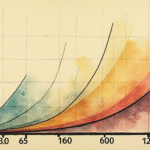Introduction
Philippa “Pippa” Malmgren, author of “Geopolitics for Investors” and “The Infinite Leader,” will be in Mexico today to deliver a conference titled “Agentic AI, Innovation and Imagination” at a Deloitte event with Latin American business leaders. In our conversation before the event, Malmgren boldly declared Mexico as “the new China,” capturing my immediate attention.
Malmgren’s Perspective on Global Leadership
Malmgren emphasizes that effective global leadership requires understanding the realities of the world, not relying on outdated assumptions. She points out that many leaders still view China as the most intertwined economy with the United States, while Mexico now leads in this aspect. Malmgren has been advocating for Mexico as “the new China” for the past three to four years, when it seemed more far-fetched.
Mexico’s Economic Advantages
Malmgren asserts that Mexico has stronger supply chains with the United States than China, with better quality control, especially for high-value goods. Her costs are either equal to or lower than China’s, making Mexico the more dynamic emerging market alongside a more dynamic industrialized economy. This combination creates a “powerful growth story,” which she believes most leaders have yet to grasp.
Geopolitical Disputes and Easier US-Mexico Relations
Malmgren highlights the disruptive geopolitical tensions between the United States and China, contrasting them with the relatively smoother relationship between the US and Mexico. Despite recent events, she notes that there are many areas of agreement between the two countries.
Rapid Market Evolution
Malmgren observes the rapid evolution of bond and stock markets, with funds quickly raised for cutting-edge companies like those investing in AI in Saudi Arabia. She also points out the unprecedented liquidation of US bonds in recent years, causing unease among many.
Dólar Fall Prediction
Malmgren clarifies that higher yields make it more likely for pension funds to invest in these assets. Most market participants aren’t overly concerned about drastic liquidation, viewing it as a necessary risk revaluation. The question remains whether this adjustment is due to the US’s dire situation or a necessary “emergency surgery.” Given the US’s history of addressing and solving problems, she believes there is room for optimism.
Post-Globalization Era
Malmgren doesn’t see the end of globalization but rather the beginning of “glocalization,” a blend of global and local elements. The initial globalization meant jobs moving to China, while the new globalization implies jobs relocating to Mexico, Argentina, Vietnam, and African countries. This is genuine manufacturing relocation.
Foreign Investment in the US
Malmgren believes that European and American companies that have invested outside the US should consider manufacturing their products in Mexico or the US. She cites Toyota’s successful Kentucky factory and Haier’s acquisition of GE’s appliance division in South Carolina as examples. This challenges the notion that foreign companies cannot manufacture profitably in the US.
Opportunities for Mexican Companies
Malmgren asserts that many Mexican companies have invested in US plants, and more should follow suit. She recalls Cemex’s successful cement production in the UK, demonstrating that foreign companies can thrive within the largest consumer market.
South-South Exchanges and New Trade Options
Malmgren questions why there aren’t more business relationships between Latin American and Southeast Asian companies. She suggests that cultural differences, fewer personal connections, or comfort with US trade might be factors.
Digital Innovation in Latin America
Malmgren uses Rwanda as an example of digital innovation. Despite a recent genocide, Rwanda aims to become Africa’s Singapore by embracing innovation. They understand the importance of space in future economies, aiming to provide global internet access without infrastructure through megaconstellations.
AI and the Future of Work
Malmgen addresses AI-related job fears by reframing the narrative. She suggests that humans shouldn’t lift heavy objects, so robotics and automation are acceptable. Instead of viewing AI as a replacement, she proposes seeing it as an enhancement, expanding human capabilities.
AI as a Capacity Booster
Malmgren explains that AI improves analytical and mathematical abilities, freeing humans to focus on creativity, empathy, and emotional intelligence. She cites space satellites and advanced microscopes as examples of AI-powered tools expanding human vision and creativity.
Green Energy Solutions
Malmgren mentions China’s solar energy space project, which could provide clean, affordable energy globally. If Latin America had access to this technology, it would be a game-changer.
The True Revolution
Malmgren concludes that the real revolution lies in dedicating more time and energy to what it means to be human, fostering empathy, creativity, and emotional intelligence. This shift represents a genuine transformation in human history.






